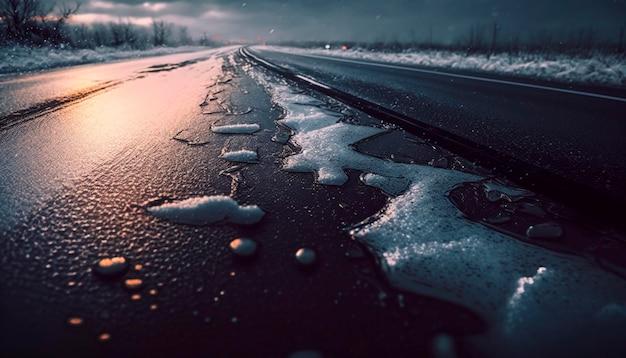Picture this: you’re driving down the road after a light drizzle. Suddenly, as you make a turn, your car starts to slide, completely out of your control. Panic sets in as you desperately try to regain traction on the slippery surface. We’ve all been there, haven’t we?
In this blog post, we’re going to delve into the fascinating world of why roads become oh-so-slippery when it first rains. We’ll explore the main cause of hydroplaning, the conditions that make roads most treacherous, and the safest way to handle your vehicle when it starts to hydroplane. So buckle up, because we’re about to unveil the secrets behind this wet and wild phenomenon.
Let’s dive right in and discover how rain turns ordinary roads into slippery slopes that test our driving skills.

Why Do Roads Turn into Slip ‘n Slides When It Starts Pouring
You wake up in the morning, ready to conquer the day, and boom! It’s raining cats and dogs outside. You begrudgingly accept the fact that you can’t teleport to work, so you grab your umbrella and head out. But as soon as you step foot on the road, you can’t help but feel like Bambi on ice. Why on earth do roads become like Slip ‘n Slides when it first rains? Let’s dive into the science behind this slippery situation and uncover the mysteries of wet roads.
The Dance of Water and Oil
You know that feeling when you try to mix oil and water? They just don’t get along, do they? Well, the same chemistry experiment is happening on the roads when it rains. You see, roads are typically made of asphalt, a mixture of gravel, sand, and a binding agent called bitumen. Bitumen is like the road’s superhero—it holds everything together and keeps it sturdy. But here’s the catch: bitumen is oil-based, and we all know that oil and water don’t see eye to eye.
When it rains, the water forms a thin film on the road. And guess what? Bitumen, being the oil-based champion it is, repels water. This slippery situation arises because the water gets trapped between the tires of your vehicle and the road, creating a treacherous layer that can turn your dream of a smooth commute into a hydroplaning nightmare.
The Infamous Hydroplaning
Hydroplaning: the nemesis of every driver when the heavens decide to open up. It’s that heart-stopping moment when your car completely loses its grip on the road and starts gliding like an ice skater. But fear not! Science has an explanation for this notorious phenomenon.
When it first starts raining, the water mixes with oil residues, tire debris, and all the gunk on the road, forming a slick and hazardous cocktail. This layer of impurities combines with the thin film of water to create a treacherous surface—which, as we’ve established, is not a friend to your tires.
As you drive over this hazardous concoction, your tires struggle to maintain traction. The water acts as a barrier, preventing your tires from properly gripping the road. Instead, they glide over the water, leaving you at the mercy of physics and praying that your brakes remember their duty.
The Role of Tire Treads
Now, you might be wondering, “What’s the big deal? Why can’t our trusty tires handle a little water?” Well, my friend, it all comes down to friction, or rather, the lack thereof.
Under normal conditions, your tire treads act as the heroes of the road, gripping the pavement like a vice grip on your morning coffee. However, when it rains, those deeply grooved treads that are designed to provide excellent traction encounter a challenge. The water on the road fills those grooves, reducing the surface area of the tire that actually makes contact with the road. Without proper contact, the friction needed to keep your vehicle stable and safe diminishes drastically.
Imagine trying to shake someone’s hand with a gloved hand—there’s just not enough skin-to-skin contact to establish a solid grip. The same goes for your tires in the rain. Without sufficient contact between the tire and the road, the friction diminishes, making your vehicle more vulnerable to the whims of momentum and gravity.
So, there you have it! The reason why roads turn into slippery slopes when it first rains boils down to the chemistry between water and oil, the formation of treacherous layers, and the loss of friction caused by water-filled tire treads. Next time you find yourself slip-sliding away on a rainy day, remember the intricate dance of science happening beneath your wheels.
Now that you’re armed with this knowledge, be cautious, drive slowly, and don’t forget to pack your fairy wings in case you need a little extra help staying upright on your journey. Stay safe out there, fellow road warriors!

FAQ: Why Are Roads Slippery When It First Rains
Welcome to our comprehensive FAQ-style guide on why roads become slippery when it first rains. In this guide, we will address common questions about this phenomenon, explain the main causes of hydroplaning, and provide tips on how to stay safe while driving in wet conditions. So let’s dive in!
What Causes Hydroplaning
When it comes to understanding why roads become slippery during the initial rainfall, one of the main factors at play is hydroplaning. Hydroplaning occurs when a vehicle’s tires lose contact with the road surface due to a layer of water. The main cause of hydroplaning is the reduced friction between the tires and the wet road, which prevents the tires from effectively gripping the surface.
How Much Water Can Cause Hydroplaning
The amount of water on the road plays a crucial role in determining the likelihood of hydroplaning. As a general rule of thumb, even a thin layer of water, as little as one-twelfth of an inch, can increase the risk of hydroplaning. Hence, it is important to exercise caution and adjust your driving behavior when encountering any amount of water on the road.
Why Do Roads Become Slippery When It First Rains
The reason roads tend to be more slippery during the initial rainfall is due to the mix of oil, dust, and debris that accumulates on the road surface over time. When it first starts raining, the water combines with these substances to create a slick layer, making the road particularly slippery. This phenomenon is often referred to as “oil slick” and can significantly reduce traction.
When Does the Road Become the Most Slippery While Driving in the Rain
While roads can be slippery throughout a rainstorm, they are typically most treacherous during the early stages. This is when the rainwater has just begun to mix with the oils and grime on the road, creating a high potential for hydroplaning. Stay alert and maintain a steady and cautious driving approach during these initial stages of rainfall to avoid any mishaps.
How Can You Check the Mirror Blind Area Group of Answer Choices
Checking the mirror blind area is crucial, especially while driving in wet conditions. To ensure your safety, follow this simple technique:
-
Shoulder Check – Before changing lanes or making a turn, turn your head to check your blind spot. This way, you can physically confirm if any vehicles are present in your blind spot.
-
Adjust the Side Mirrors – Properly adjust your side mirrors to maximize your field of view. Position them so that you can see the edge of your vehicle in the mirror, as this will minimize blind spots.
-
Use Technology – Many modern vehicles are equipped with blind-spot detection systems, which can provide additional assistance. These systems use sensors to alert you when a vehicle is detected in your blind spot.
Should You Press Down on the Accelerator and Brake Hard When Hydroplaning Begins
Absolutely not! When you start hydroplaning, it is essential to remain calm and avoid sudden, aggressive actions with the pedals. Slamming on the accelerator or brake can exacerbate the situation and cause loss of control over your vehicle. Instead, ease off the accelerator and try to gently steer your vehicle straight until you regain traction.
What Are Three Signs of Reduced Visibility While Driving in the Rain
-
Raindrop Distortion – If you notice raindrops creating a hazy or distorted view through your windshield, it suggests reduced visibility. This distortion can make it challenging to see clearly, especially when it’s dark or raining heavily.
-
Diminished Headlight Effectiveness – If the beams from your headlights appear less effective, and you struggle to see a significant distance ahead, it indicates reduced visibility. The rain can scatter light, reducing its effectiveness in illuminating the road ahead.
-
Difficulty Spotting Road Markings and Signs – When you find it difficult to identify road markings, signs, or other vehicles from a reasonable distance, it’s a clear sign of reduced visibility. This reduced visibility can make it challenging to navigate and react appropriately to potential hazards.
What Is the Safest Way to Slow Your Vehicle Once It Starts Hydroplaning
Slowing down during hydroplaning requires a cautious approach. To safely reduce your vehicle’s speed, follow these steps:
-
Stay Calm – Keep a steady grip on the steering wheel and remain calm to maintain control over your vehicle.
-
Ease Off the Accelerator – Remove your foot from the gas pedal and let your vehicle gradually decelerate. This will help re-establish traction with the road.
-
Avoid Sudden Braking – Resist the urge to slam on the brakes, as it can cause skidding or further loss of control. Instead, gently apply the brakes in a controlled manner.
How Can You Recover from Hydroplaning
If you find yourself hydroplaning, don’t panic! Follow these steps to safely recover from the situation:
-
Stay Steady – Keep a firm grip on the steering wheel and try to stay calm. Avoid sudden or jerky movements that could worsen the situation.
-
Ease Off the Gas – Let go of the accelerator to reduce speed and help your tires regain contact with the road.
-
Steer Gently – Make small and gradual steering adjustments to stay in your lane and avoid any sudden course corrections.
-
Avoid Braking – As much as possible, refrain from using the brakes until you regain control over your vehicle. Braking during hydroplaning can lead to skidding or further loss of control.
Under Which Conditions Is a Road Likely to Be Most Slippery
While roads can become slippery anytime it rains, the most treacherous conditions occur when the road has undergone a dry spell. During dry weather, oil, dust, and debris accumulate on the road surface, creating a layer that reduces friction. When rain finally arrives, this mix makes the road exceptionally slippery, increasing the risk of hydroplaning.
Why Are Roads Slippery After a Dry Spell
After a dry spell, oil, dust, and debris build up on the road surface. When the rain finally arrives, it mixes with this accumulated residue to create a slick surface. This phenomenon is often referred to as the “first flush,” as the initial rainfall washes away the built-up grime, making the road particularly slippery. It is crucial to exercise caution during this period until the road surface cleanses itself.
Understanding why roads are slippery when it first rains is essential for ensuring safe driving. By being aware of the causes of hydroplaning, recognizing the signs of reduced visibility, and adopting appropriate driving techniques, you can navigate wet roads confidently. So next time it rains, embrace the road with caution and care to reach your destination safely. Stay safe out there!
Note: The information provided in this FAQ-style guide is for general informational purposes only and should not be considered professional advice. Always exercise caution and follow local traffic laws and regulations.
